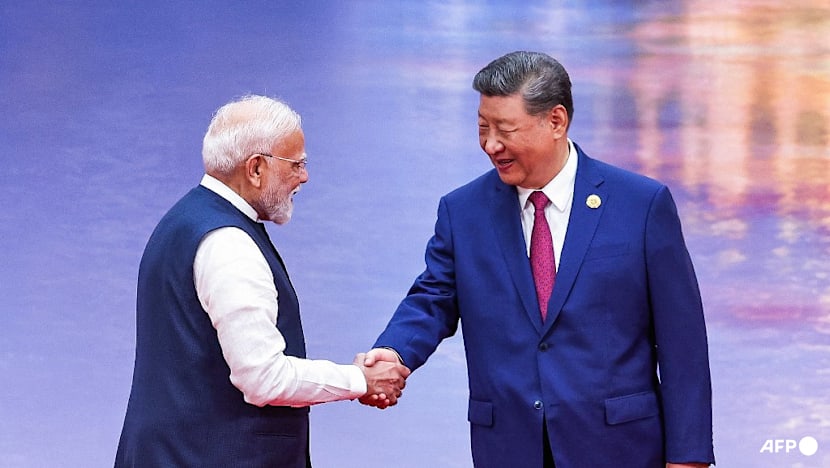Commentary: A China-India thaw is underway, but flashpoints haven’t gone away
China and India are easing tensions, but the sensitive terrain of territorial disagreements and overlapping regional ambitions remains in the way, says Daniel Balazs of the S Rajaratnam School of International Studies.

India’s Prime Minister Narendra Modi and China’s President Xi Jinping shake hands during the welcome ceremony of the Shanghai Cooperation Organization (SCO) summit in Tianjin on Aug 31, 2025. (Photo: AFP/Indian Press Information Bureau)

This audio is generated by an AI tool.
SINGAPORE: “It should be the right choice for China and India to be good-neighbourly friends and partners that help each other succeed, and have the dragon and the elephant dance together,” said Chinese President Xi Jinping at his meeting with Indian Prime Minister Narendra Modi in Tianjin on Sunday (Aug 31).
The dragon and elephant metaphor is often used to describe the geopolitical and economic ties between China and India. At times, they fight. At times, they co-exist. And at times, they dance.
Mr Xi invoked the imagery at his meeting with Mr Modi on the sidelines of the Shanghai Cooperation Organization Summit, at a time when both countries are trying to stabilise a historically uneasy relationship. The visit marked the first trip to China by Mr Modi in seven years.
The two Asian giants have great potential for collaboration. They are among the 10 biggest economies of the world, and together boast a market of 2.8 billion people. As emerging powers, they have shared interests in global economic stability, common development and multilateralism.
These shared interests prompted recent advances in the Sino-Indian relationship. After a five-year hiatus incited by security tensions on their disputed border, they recently agreed to continue the Kailash Mansarovar Yatra pilgrimage, resume direct flights, recommence the issuing of Indian tourist visas to Chinese nationals, and are planning to reinstate border trade. At a recent meeting between their foreign ministers, the two economies committed to facilitating trade and investment ties via concrete measures.
Actions by third actors have catalysed the recent thaw between China and India. In its quest to weaken Russia’s war effort in Ukraine, the European Union sanctioned multiple Chinese and Indian entities for their purported support of Moscow. At the same time, the United States imposed hefty import tariffs on Chinese and Indian products and unleashed further levies for Indian oil purchases from Russia.
New Delhi and Beijing found common ground on this issue, pushing back against Brussels and Washington, charging them with discrimination and double standards against Chinese and Indian companies.
Against this backdrop, the leaders struck a positive tone at their meeting. They expressed appreciation for the constructive momentum and consistent advancement in bilateral ties. They reiterated that the two nations view each other as development partners rather than competitors and doubled down on their commitment to growth and multipolarity.
While current geopolitical trends facilitate the thaw in China-India relations, there are deep-rooted issues between them that can set back or even derail the process.
STICKY ISSUES RELATED TO THE BORDER AND RIVER FLOWS
China and India share a disputed border spanning thousands of kilometres. In 2020, after decades of bloodless militarised interaction in the contested regions, a deadly conflict erupted, claiming the lives of at least 20 Indian and four Chinese soldiers.
While the 2024 border patrol agreement brought back stability on the border, a long list of sensitive issues between China and India remains.
According to recent reports, China plans to construct a rail link between Xinjiang and Tibet, which will reportedly run close to disputed areas. On the other side of the Himalayas, India has been upgrading its infrastructure in the disputed region.
Furthermore, China recently started the construction of the largest hydropower project in the world, the Motuo Hydropower Station. The dam’s location on the transboundary Yarlung Tsangpo river may enable China to divert or control the river's water flows and potentially harm the interests of downstream states, such as India. New Delhi formally articulated concerns over the dam’s potential impact on regional stability and water flows.
While these developments have not derailed the Sino-Indian rapprochement, they can spur protracted discontent between the two sides and become flashpoints in the future. The example of the 2020 Galwan conflict shows that border-related issues can escalate and freeze ties for years.
OVERLAPPING REGIONAL AMBITIONS
The boundary problem and river flows are far from the only friction points between China and India. The two countries are both key regional players in each other’s backyards, and their overlapping regional activities tend to frustrate one another.
China’s close ties with Sri Lanka, the Maldives, Bangladesh and Pakistan have long been viewed as a threat to India's strategic interests. These ties, based on Chinese investments, loans and arms supplies, have triggered concerns of encirclement in New Delhi.
On the other side of the equation, some of India’s strategic activities in Southeast Asia draw concern from China. In early August, India and the Philippines conducted their first joint maritime exercise in the South China Sea. Beijing is wary of non-regional states’ strategic presence in the area, and after the joint maritime drill, warned third parties not to interfere in the South China Sea dispute.
SOUTHEAST ASIA AND CHINA-INDIA TIES
In sum, the China-India thaw is underway, but New Delhi and Beijing have to navigate the sensitive terrain of territorial disagreements and overlapping regional ambitions.
This nuanced geopolitical setting brings opportunities and challenges to Southeast Asian states.
The positive direction of ties between China and India enhances stability in the Asia-Pacific. The lower likelihood of a military conflict benefits Southeast Asian states as they can focus on deepening ties with China and India. Closer interaction with Beijing and New Delhi can mitigate the fallout of US tariff policies and strategic retrenchment.
With the opportunity comes challenges. First, as long as the border dispute is not resolved, the ties between China and India can turn volatile at any moment. This requires agile policymaking that is prepared for worst-case scenarios, such as a spike in tensions on the Sino-Indian border followed by a downturn in their bilateral ties.
Second, as China and India vie for influence in Southeast Asia, regional states have to balance their strategic engagements carefully to maintain equidistance between them for the sake of preserving strategic flexibility.
Third, US tariffs already triggered a flow of cheap Chinese goods to Southeast Asia. The situation could turn for the worse if the US and China fail to reach an agreement and Washington maintains hefty tariffs on Beijing.
Now that India is also among the states heavily hit by US tariffs, Indian firms might follow the Chinese playbook and double down on sales to Southeast Asian markets. Therefore, regional states must monitor trade rerouting patterns to protect local businesses from being undercut by cheap imports from China and India.
Ultimately, the trajectory of China-India relations will play a key role in shaping Southeast Asia’s security landscape, geoeconomic outlook, and its capacity to manoeuvre within an increasingly complex, multipolar order.
Daniel Balazs is a Research Fellow in the China Programme of the S. Rajaratnam School of International Studies, Nanyang Technological University, Singapore. The views expressed are his own and do not represent the views of his affiliated institutions.


















